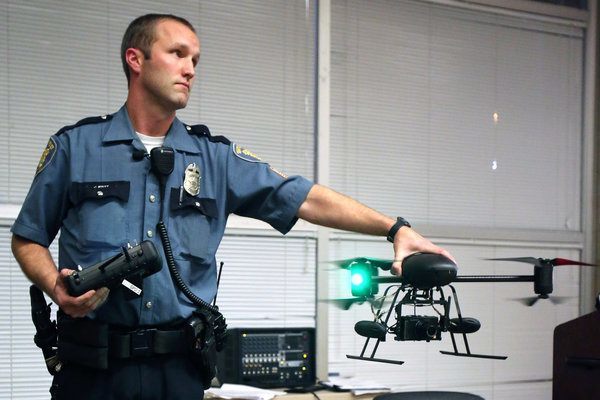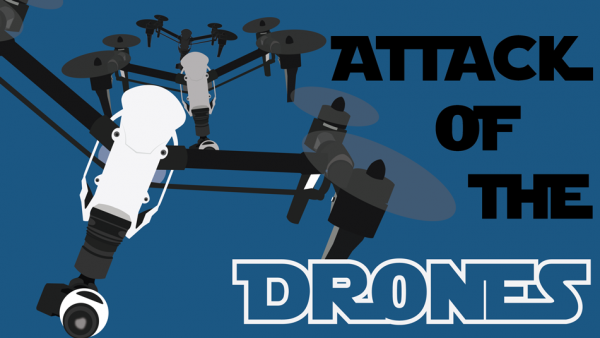

Drones are gaining popularity as toys for both young and old. They, have come from being simple kite alternatives to actual extensions of their users that can be used to view, observe and unfortunately spy on others. Amazon is actually in the process of researching product delivery through drones. Drones will soon deliver products right at people’s doorsteps. Used in the latter applications, drones are basically intrusive. Flying a drone over a neighbor’s lawn is already a cause of concern for some, especially flying one over a neighbor’s lawn with a camera attached. As an extension of the owner, it can be considered trespassing. Many a drone have been shot down for such a cause. Most of the time, seeing a drone, let alone a kite in one’s airspace triggers a response to investigate, in other words, it’s bothersome. It’s basically the same thing when an unidentified aircraft enters an airport airspace. And it’s a bigger problem when a drone actually enters airport airspace and disrupts air traffic.

But as with the internet, the idea of fun is subjective. Some like cat videos, others like porn. With drones, owners can capture their own adventures biking or rock climbing, or peep through Jennifer Lawrence’s window while she’s undressing from a hundred yards away. With improvements in camera technology, the drone might as well be a fly on the wall. Another problem with drones (aside from those used by the military), is that they have the potential to be used as weapons or spy equipment. There was this news where a man was hurt (or was he decapitated) when he made a mistake in landing his gas-powered remote-controlled helicopter. Though not exactly a drone but a careless pilot could land a drone on someone’s head, hit a small child or someone’s pet. A drone could also be intentionally used to drop a deadly package on someone’s home or head. A more recent news is about a drone that crashed in the White House lawn. It could have been worse if the drone had some C4 or was aimed at the president’s head. What’s actually surprising is the lack of surface to air technology around the white house itself to intercept anything unscheduled coming from the air.
The larger the drone, the more dangerous it can be. High-end drones which have a long range can also be a danger to air traffic as they can be hit by low flying aircraft. Drones are a serious concern for celebrities as they can be used by paparazzi to eavesdrop within their residences. And because privacy and security from terrorism are such buzzwords, it can’t be helped that government rules have to be made. The Federal Aviation Administration has already made some proposals such as:
- Daylight-only operations and operators should consider weather conditions
- No careless or reckless operations. Operators should keep away from airports and other restricted airspace.
- Maximum airspeed of 100 mph. Any faster and they can be used as missiles.
- Maximum altitude of 500 feet above ground level. Any higher and they can disrupt air traffic
- Must not fly over people except the operators
The aforementioned are general rules that cover all drones. For large utility drones weighing 55 pounds or less, the FAA proposes that:
- Users must be at least 17 years old
- Pass an aeronautical knowledge test at an FAA-approved knowledge testing center
- Pass a recurrent aeronautical knowledge test every 24 months
- Obtain an unmanned aircraft operator certificate with a small UAS rating
- Conduct a pre-flight inspection, to include specific aircraft and control station systems checks, to ensure the small UAS is safe for operation
- Report an accident to the FAA within 10 days of any operation that results in injury or property damage
- Make available to the FAA, upon request, the small UAS for inspection or testing, and any associated documents/records required to be kept under the proposed rule
The rules mentioned are practically similar to getting driving or pilot licenses which might as well be as 55-pound drones are technically unmanned aircraft that have the potential to cause harm or damage to property if not properly handled. What will be the future of drones when the government gets these laws in place?
Believe it or not, a set of rules by the government as long as they’re clear and not too restrictive simplifies things. Drone owners no longer need to guess or wonder whether or not they’re flying at the right place or even doing the right thing. Given the above sets of laws, drone manufacturers now have a set of parameters they can follow and make drones for both consumer and business use. If a consumer drone can’t fly over 500 feet or fly at speeds of 100mph, it saves the owner any worries about breaking any laws. That’s freedom in itself. All drone owners need to do is just to stay away from airports, celebrity mansions and the lawn of the local curmudgeon. Don’t carry any clocks or explosives. Get your drone license along with your driver’s license and everything should be okay.

